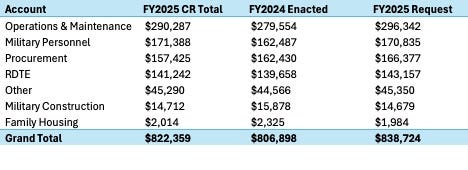The Continuing Resolution That Isn’t
Under the terms of H.R 1968, the recently passed continuing resolution (CR), the Department of Defense will have access to what amounts to a self-guided appropriations bill.
H.R. 1968, the continuing resolution that passed both the House and the Senate the week of March 14th, presents a structure that is novel for a CR (in ~15 years of monitoring the US budget I’ve never seen this). The Department of Defense is basically provided with the normal appropriations guidance for spending at the account level and given the opportunity to present a more detailed plan within 45 days of passage. This plan is only constrained by the appropriations bills passed in the House and introduced in the Senate in the previous Congress.
It's unclear what visibility the public would have on these decisions. Typically, the line item detail for appropriations is made available in legislation, but given that this would be a reprogramming exercise it may not become available.
Overall, the toplines provided for DoD under H.R. 1968 are being reported as being an $8 billion increase over FY 2024 levels. However, the actual funding level specified at the account level relative to the Public Budget Database suggest a more significant increase of $15 billion. The difference is likely accounted for in the rescissions section. If one includes the defense supplementals from FY 2024, the picture is more bleak as real spending will decline by roughly 6.4% year over year.
Beyond the slight increase in base spending, there are additional provisions to provide flexibility given the short time before the end of FY 2025. Section 1411 of the bill raises the cap for spending in the final two months of the fiscal year from 20% of total spending to 40% of total spending.
The net impact of all of this is to give DoD considerable flexibility in spending its FY 2025 appropriation. This will give Secretary of Defense Hegseth and the new leadership considerable opportunity to put its imprint on the department. Interested contractors and advocates should track carefully the reprogramming process going forward to watch how the department’s priorities shift given the new flexibility.




